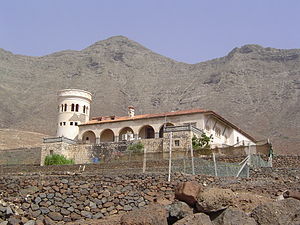Villa winter
The Villa Winter ( Spanish Casa Winter ) is a property near the town of Cofete on the west coast of the Jandía peninsula on the Canary Island of Fuerteventura .
History of the property
The villa was named after the German engineer Gustav Winter, who was born on May 10, 1893 in Zastler in the Black Forest , and is surrounded by rumors and mysteries. The house, built in 1936, consists of two floors, a tower in a north-easterly direction and a partially closed basement. In some travel guides it is also mentioned as the "vacation home of a German general".
Gustav Winter worked in Spain since 1915 and was involved in various projects on the mainland, on Gran Canaria and finally on Fuerteventura. The usual speculations about the tasks of Gustav Winter and the function of the finca in Cofete are:
- Establishment of a secret submarine port during the Second World War
- Temporary accommodation of Nazi giants and their transport to South America at the end or after the end of the Second World War.
All serious research by German and Spanish journalists has not been able to prove or refute any of these speculations, which are rich in variety. All indications such as supposedly thick walls, " pagan " carvings, oversized power lines and strange towers can be traced back to normal contemporary construction methods of a German engineer as well as technical availabilities at the time. In the attic in particular, there are typically southern German wooden constructions, as they were common in the Black Forest at that time and in this form are unique on the entire Canary Islands.
However, information from Winters in an interview given to the magazine “ Stern ” in 1971, shortly before his death, has fueled speculation ever since: in it he gave the year 1958 as the time the villa was built. As a reason for the extremely remote and poorly accessible location, he cited being a nature lover. His efforts to build a tomato plantation also seem at least questionable due to the inhospitable nature of the area and the natural lack of water. No explanation was found for the airfield located about 12 km to the west .
All of the motifs documented by contemporary witnesses and still understandable today are agricultural activities on the west and east coast. Furthermore, Winter was responsible for the construction of a road from the east coast, starting between Costa Calma and Jandía, towards the west coast. The construction of this partly asphalt road, which is still passable today and which is now on private property, was only carried out up to the saddle of the mountain range. A descent to the west was not realized.
After Gustav Winter's death († 1971), the villa remained in the family's possession. In 1997 the family sold the property to the Spanish Lopesán Group.
In the summer of 2015, History produced the multi-part documentary “Hunting Hitler” (German: “Hitler's flight: truth or legend?”). Part six of the first season deals with speculation about the Villa Winter and the surrounding area.
Picture gallery
literature
- Juan Pedro Martin Luzardo: Origenes de la Propiedad en la Peninsula de Jandia . 2003, ISBN 978-84-607-7725-0 (Spanish).
Web links
- The secret of "Villa Winter". In: sueddeutsche.de. sueddeutsche.de GmbH / Süddeutsche Zeitung GmbH, April 28, 2006, accessed on May 28, 2009 .
- Villa Winter - witnesses to the past
- www.casawinter.com
Individual evidence
- ↑ Itziar Fernández: Última batalla en la misteriosa villa Winter de Cofete. In: diariodefuerteventura.es. January 7, 2017, Retrieved December 7, 2017 (Spanish).
- ↑ Hitler's Escape: Episode Guide - An overview of all episodes. In: history.de. Retrieved June 6, 2018 .
- ↑ Hitler's Flight: Truth or Legend? Part 6 on dailymotion, from 8:40.
Coordinates: 28 ° 6 ′ 6.5 ″ N , 14 ° 22 ′ 30 ″ W.




